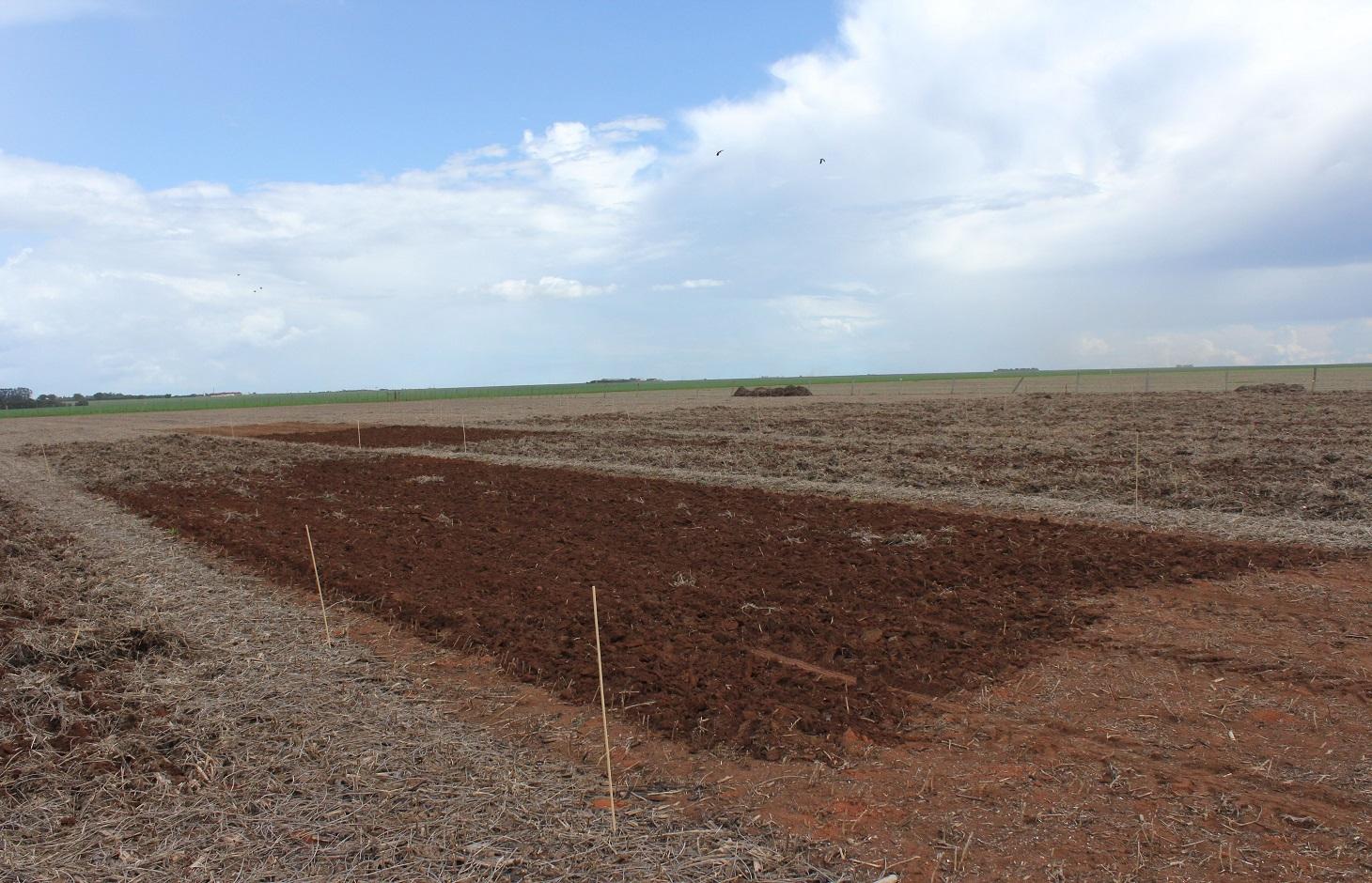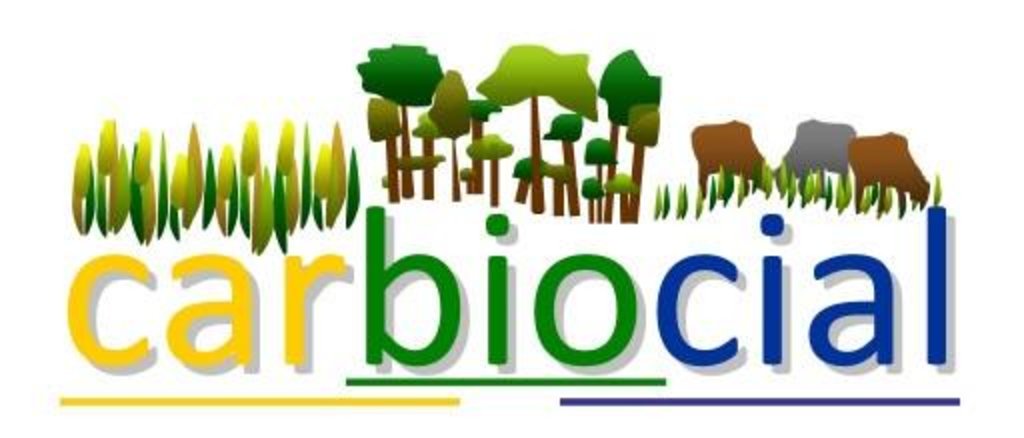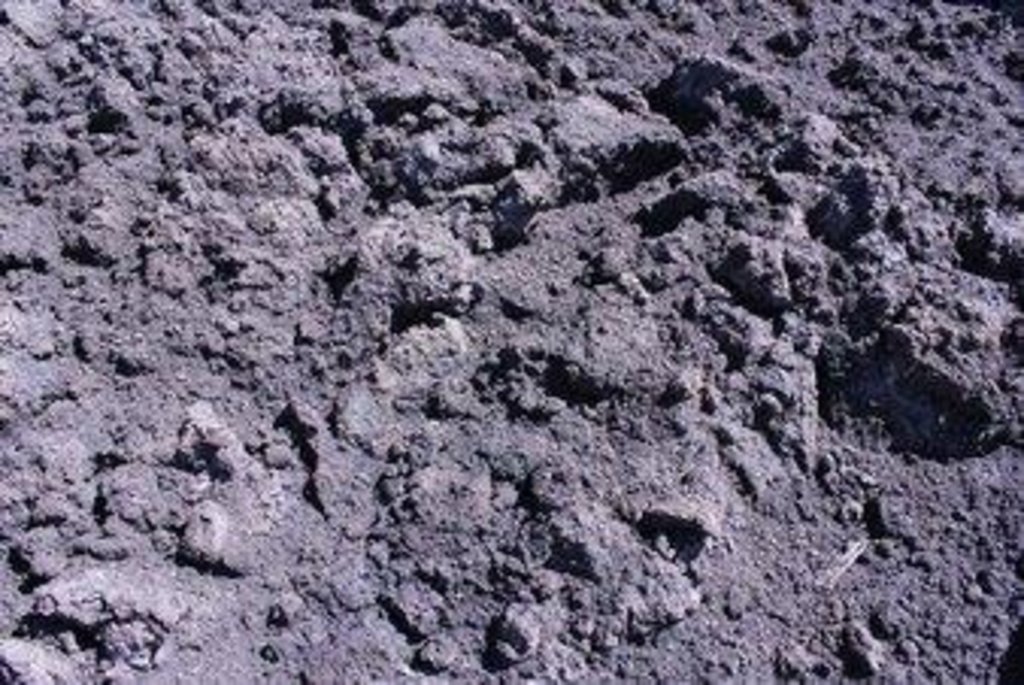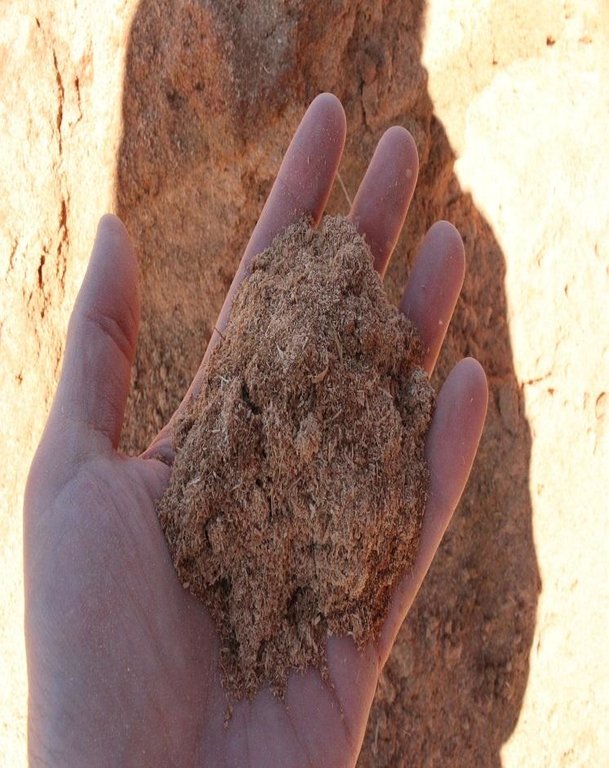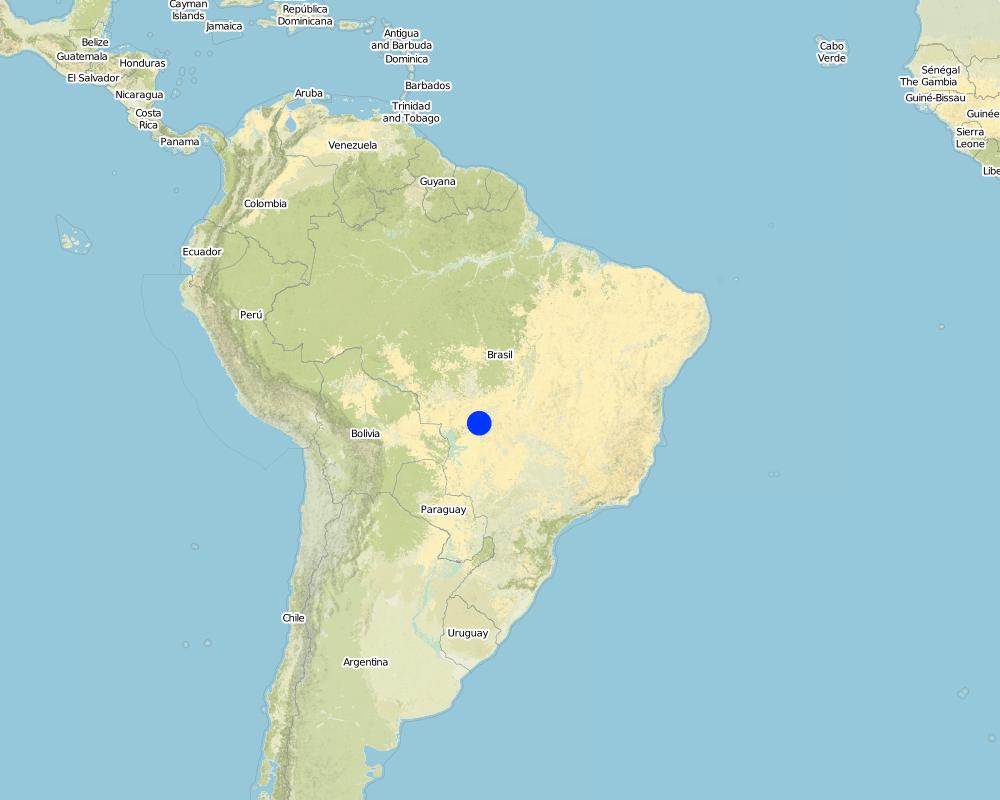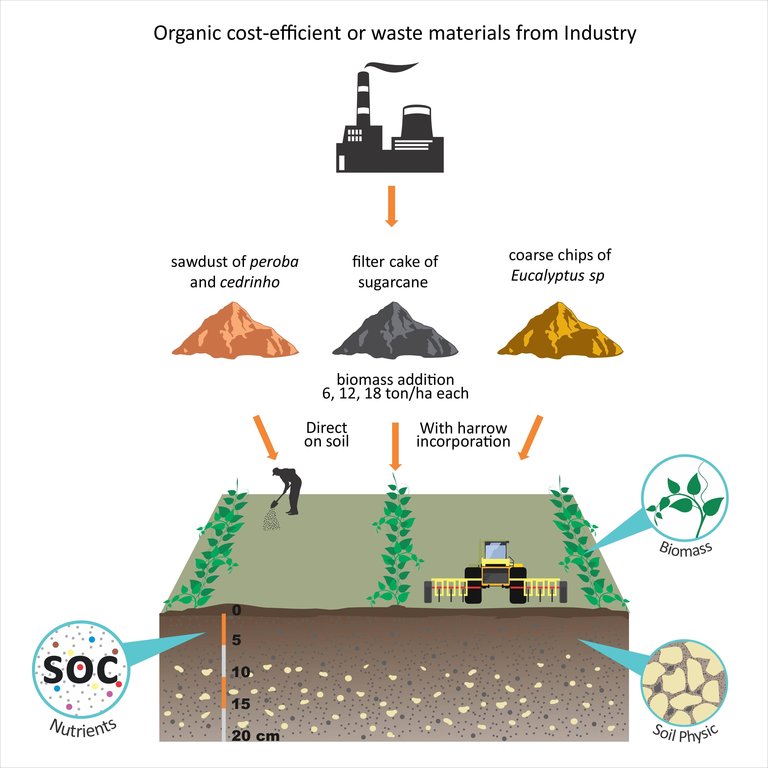Carbon-enrichment of tropical agricultural soil with organic matter [บราซิล]
- ผู้สร้างสรรค์:
- การอัพเดท:
- ผู้รวบรวม: Luisa F. Vega
- ผู้เรียบเรียง: –
- ผู้ตรวจสอบ: Deborah Niggli, Alexandra Gavilano
Enriquecimento de carbono em solo de lavoura com matéria orgânica (Brazil)
technologies_1250 - บราซิล
- บทสรุปทั้งหมดในรูปแบบของ PDF
- บทสรุปทั้งหมดในรูปแบบของ PDF เพื่อพิมพ์
- บทสรุปทั้งหมดในรูปหน้าเว็บ
- บทสรุปทั้งหมด (ไม่มีการจัดเรียง)
- Carbon-enrichment of tropical agricultural soil with organic matter: 5 มกราคม 2017 (inactive)
- Carbon-enrichment of tropical agricultural soil with organic matter: 7 มีนาคม 2017 (inactive)
- Carbon-enrichment of tropical agricultural soil with organic matter: 29 เมษายน 2017 (inactive)
- Carbon-enrichment of tropical agricultural soil with organic matter: 7 มีนาคม 2019 (public)
ดูส่วนย่อย
ขยายทั้งหมด ย่อทั้งหมด1. ข้อมูลทั่วไป
1.2 รายละเอียดที่ติดต่อได้ของผู้รวบรวมและองค์กรที่เกี่ยวข้องในการประเมินและการจัดเตรียมทำเอกสารของเทคโนโลยี
ผู้เชี่ยวชาญ SLM:
Irmler Prof. Dr. Ulrich
uirmler@ecology.uni-kiel.de
Institute for Ecosystem Research
Christian-Albrechts-Universität Kiel, 24118 Kiel, Germany
เยอรมนี
ผู้เชี่ยวชาญ SLM:
Wantzen Prof. Dr. Karl M.
karl.wantzen@univ-tours.fr
CNRS UMR CITERES
University of Tours 37200 Tours, France www.karlmwantzen.de
ฝรั่งเศส
ชื่อของโครงการซึ่งอำนวยความสะดวกในการทำเอกสารหรือการประเมินเทคโนโลยี (ถ้าเกี่ยวข้อง)
Book project: Making sense of research for sustainable land management (GLUES)ชื่อขององค์กรซึ่งอำนวยความสะดวกในการทำเอกสารหรือการประเมินเทคโนโลยี (ถ้าเกี่ยวข้อง)
University of Kiel (University of Kiel) - เยอรมนีชื่อขององค์กรซึ่งอำนวยความสะดวกในการทำเอกสารหรือการประเมินเทคโนโลยี (ถ้าเกี่ยวข้อง)
Universidade Federal de Mato Grosso (Universidade Federal de Mato Grosso) - บราซิลชื่อขององค์กรซึ่งอำนวยความสะดวกในการทำเอกสารหรือการประเมินเทคโนโลยี (ถ้าเกี่ยวข้อง)
Université Francois-Rabelais de Tours (Université Francois-Rabelais de Tours) - ฝรั่งเศส1.3 เงื่อนไขการใช้ข้อมูลที่ได้บันทึกผ่านทาง WOCAT
ผู้รวบรวมและวิทยากรหลักยอมรับเงื่อนไขเกี่ยวกับการใช้ข้อมูลที่ถูกบันทึกผ่านทาง WOCAT:
ใช่
1.4 การเปิดเผยเรื่องความยั่งยืนของเทคโนโลยีที่ได้อธิบายไว้
เทคโนโลยีที่ได้อธิบายไว้นี้เป็นปัญหาของความเสื่อมโทรมโทรมของที่ดินหรือไม่ จึงไม่ได้รับการยอมรับว่าเป็นเทคโนโลยีเพื่อการจัดการที่ดินอย่างยั่งยืน:
ไม่ใช่
2. การอธิบายลักษณะของเทคโนโลยี SLM
2.1 การอธิบายแบบสั้น ๆ ของเทคโนโลยี
คำจำกัดความของเทคโนโลยี:
Carbon-enrichment of tropical agricultural soils with locally available organic matter in the Cerrado agricultural landscape, Brazil.
2.2 การอธิบายแบบละเอียดของเทคโนโลยี
คำอธิบาย:
In the Carbiocial Project viable land management strategies were explored to optimize the level of carbon in soil and water, helping to maintain and/or improve ecosystem functions, under changing climatic conditions in the Southern Amazon and the Brazilian Cerrado. In the framework of this project, on-farm experiments were performed to enrich tropical agricultural soils in the medium term, with different types of organic matter (OM). In the experiment the effect of different types of OM amendments on soil carbon and macro-nutrients (N, P, and K), soil physical properties (waterholding capacity) and crop yield (soy biomass and grain production) were assessed. The amendments applied are locally available, and are either free (being waste materials) or considered cost-efficient.
The objective of this on-going experiment is to compare the impact of (i) the quality and quantity of OM applied, (ii) and the application methods (directly on the soil surface or incorporation by harrow) on soil chemical and physical properties. It is hypothesised that the addition of OM can enhance crop yields and, potentially, soil biodiversity. The effects of the different OM types, amounts and application methods were evaluated after one, two and three years. From the results, the aim is to provide recommendations for the development of soil OM-enrichment schemes and carbon-friendly landscape management programs for farmers, using local resources.
The experiment was established on an area of about one hectare on a ferrasol (red latosol) at the Rio Engano Farm, in the municipality of Campo Verde, Mato Grosso State. The farm has a total area of ca. 1500 ha, 830 ha of which are cultivated with soybean and maize rotation, under a zero-tillage system, which is typical of many farms in this region. It is located in the Brazilian Cerrado (savanna) biome at about 685 m a.s.l. This biome covers 2 million km2, which is 23% of the country area. It has a semi-humid climate with a pronounced dry season. The precipitation during the rainy season (September-April) varies between 800 and 2000 mm/year.
At the beginning of the experiment (February 2012), three different types of OM amendments were applied. They comprised (a) sugarcane filter cake (Saccharum officinarum from ethanol/sugar-production, (b) sawdust of peroba and cedrinho (Peroba jaune and Erisma uncinatum, respectively) and (c) coarse chips of Eucalyptus sp. Quantities applied were 0 (control), 6, 12 and 18 tonnes of each per hectare; using two methods: directly on the soil surface, and incorporated by harrow. There were three repetitions per treatment. The area was not fenced to allow the farmers to continue with their field routines on all plots. In February 2013, 2014 and 2015 soil samples were taken to analyze their chemical and physical properties. Soybean samples were also taken in February 2014 and 2015 to estimate biomass and grain production. From the initial results some conclusions can be drawn: 1) Organic amendment addition to ferrasols can significantly increase soil organic carbon, even in amounts as low as 6 t/ha. 2) Amendments should be reapplied every 2 years. 3) The amendment type and application method does not have a significant effect on increasing soil organic carbon. 4) The addition of OM amendments is a win-win situation as a solution for organic matter waste recycling, and simultaneously to improve soil quality.
The area was not fenced to allow the farmer to continue with their arable field routines on all treatment plots. In February 2013, 2014 and 2015 soil samples were taken to analyze their chemical and physical properties. Soy bean samples were also taken in February 2014 and 2015 to estimate biomass and grain production.
From our first results we can draw some conclusions:
1) Organic amendment addition to Ferrasol can increase significantly soil organic carbon (SOC) percentage, even in small amounts such as 6 ton/ha.
2) Amendment reapplication should be done in 2 years intervals.
3) The amendment type and disposition did not have a significant effect on increasing SOC.
4) The addition of OM amendments is a win-win situation as a solution for organic matter waste recycling and to improve soil quality.
2.3 รูปภาพของเทคโนโลยี
2.5 ประเทศภูมิภาค หรือสถานที่ตั้งที่เทคโนโลยีได้นำไปใช้และได้รับการครอบคลุมโดยการประเมินนี้
ประเทศ:
บราซิล
ภูมิภาค/รัฐ/จังหวัด:
Mato Grosso
ข้อมูลจำเพาะเพิ่มเติมของสถานที่ตั้ง :
Campo Verde
Map
×2.6 วันที่การดำเนินการ
ถ้าไม่รู้ปีที่แน่นอน ให้ระบุวันที่โดยประมาณ:
- น้อยกว่า 10 ปี (ไม่นานนี้)
2.7 คำแนะนำของเทคโนโลยี
ให้ระบุว่าเทคโนโลยีถูกแนะนำเข้ามาอย่างไร:
- ในช่วงการทดลองหรือการทำวิจัย
- ทางโครงการหรือจากภายนอก
ความคิดเห็น (ประเภทของโครงการ เป็นต้น) :
The enrichment of the soil by OM application is a traditional practice. Some of the added OM types in this experimet are already used in the Cerrado without any technical specification. This project aim to identify of one or more types, amounts and application methods of OM, which improve significantly soil quality and carbon stock. The OM effects are evaluated after 2 and 3 years of its addition, which was initially done in February 2012.
3. การจัดประเภทของเทคโนโลยี SLM
3.1 วัตถุประสงค์หลักของเทคโนโลยี
- ปรับปรุงการผลิตให้ดีขึ้น
- อนุรักษ์ระบบนิเวศน์
3.2 ประเภทของการใช้ที่ดินในปัจจุบันที่ได้นำเทคโนโลยีไปใช้

พื้นที่ปลูกพืช
- การปลูกพืชล้มลุกอายุปีเดียว

ทุ่งหญ้าเลี้ยงสัตว์
ทุ่งหญ้าเลี้ยงสัตว์ที่ใช้พื้นที่กว้าง:
- การทำฟาร์มปศุสัตว์ (Ranching)
ทุ่งหญ้าเลี้ยงสัตว์ที่มีการจัดการแบบเข้มข้นหรือการผลิตอาหารสัตว์:
- ตัดแล้วขนไป / ไม่มีการปล่อยแทะเล็มเอง (Cut-and-carry / zero grazing)
แสดงความคิดเห็น:
Major land use problems (compiler’s opinion): Croplands demonstrate a reduction in soil organic matter, after their conversion from indigenous vegetation into agricultural fields. It is especially critical in the ferrasol soils of the Brazilian Cerrado, as its organic matter content is relatively low, and tropical temperatures and humidity accelerate microbial activity (Price and Sowers 2004)
Major land use problems (land users’ perception): There are also problems regarding soil compaction and rainfall regime change
Grazingland comments: There is some grazing by tapir, capibara, wild pig, ema, papagay
Type of grazing system comments: There is some grazing by tapir, capibara, wild pig, ema, papagay
3.3 ข้อมูลเพิ่มเติมเกี่ยวกับการใช้ที่ดิน
การใช้น้ำของที่ดินที่มีการใช้เทคโนโลยีอยู่:
- จากน้ำฝน
จำนวนของฤดูเพาะปลูกต่อปี:
- 2
ระบุ:
Longest growing period in days: 150, Longest growing period from month to month: November to March; Second longest growing period in days: 120, Second longest growing period from month to month: April to July
ความหนาแน่นของปศุสัตว์ (ถ้าเกี่ยวข้อง):
> 100 LU /km2
3.4 กลุ่ม SLM ที่ตรงกับเทคโนโลยีนี้
- การจัดการความอุดมสมบรูณ์ของดินแบบผสมผสาน
3.5 กระจายตัวของเทคโนโลยี
แสดงความคิดเห็น:
Total area covered by the SLM Technology is 0.011544 m2.
In the São Valentim Farm, located in the Brazilian Cerrado (savanna) biome. The experimental soil enrichment was established in February 2012, on a Ferrasol. The area was under a soybean-corn crop rotation
3.6 มาตรการ SLM ที่ประกอบกันเป็นเทคโนโลยี

มาตรการจัดการพืช
- A2: อินทรียวัตถุในดิน/ความอุดมสมบูรณ์ในดิน
- A3: การรักษาหน้าดิน
- A4: การรักษาดินชั้นล่าง
แสดงความคิดเห็น:
Type of agronomic measures: manure / compost / residues, zero tillage / no-till, non-inversion tillage
3.7 รูปแบบหลักของการเสื่อมโทรมของที่ดินที่ได้รับการแก้ไขโดยเทคโนโลยี

การกัดกร่อนของดินโดยน้ำ
- Wt (Loss of topsoil): การสูญเสียดินชั้นบนหรือการกัดกร่อนที่ผิวดิน

การเสื่อมโทรมของดินทางด้านเคมี
- Cn (Fertility decline): ความอุดมสมบูรณ์และปริมาณอินทรียวัตถุในดินถูกทำให้ลดลงไป (ไม่ได้เกิดจากสาเหตุการกัดกร่อน)

การเสื่อมโทรมของดินทางด้านกายภาพ
- Pc (Compaction): การอัดแน่น

การเสื่อมโทรมของดินทางด้านชีวภาพ
- Bs (Quality and species composition): องค์ประกอบหรือความหลากหลายทางคุณภาพและชนิดพันธุ์ลดลง
แสดงความคิดเห็น:
Main causes of degradation: soil management (Extensive areas of monoculture), crop management (annual, perennial, tree/shrub) (Intensive soil use), deforestation / removal of natural vegetation (incl. forest fires) (In the region, the native vegetation of Cerrado was deforested during the early 80´s for agricultural purposes.), population pressure (Most of the agricultural production from The Brazilian Cerrado meet the food demand from Europe and China)
Secondary causes of degradation: Heavy / extreme rainfall (intensity/amounts) (There is an increase of extreme rainfall events which take place during the rainy season), labour availability (Reduction of availability of skilled labor for instance, to carry out integral monitoring of plagues), education, access to knowledge and support services (There a positive relationship between education level of farmers and the adoption of new technologies for sustainable land management), governance / institutional (Part of the colonization and conversion of the Brazilian Cerrado into agricultural systems was encouraged by Research (Embrapa) and Financing Government Programs)
3.8 การป้องกัน การลดลง หรือการฟื้นฟูความเสื่อมโทรมของที่ดิน
ระบุเป้าหมายของเทคโนโลยีกับความเสื่อมโทรมของที่ดิน:
- ลดความเสื่อมโทรมของดิน
4. ข้อมูลจำเพาะด้านเทคนิค กิจกรรมการนำไปปฏิบัติใช้ ปัจจัยนำเข้า และค่าใช้จ่าย
4.1 แบบแปลนทางเทคนิคของเทคโนโลยี
4.2 ข้อมูลจำเพาะด้านเทคนิคและการอธิบายแบบแปลนทางเทคนิค
Enrichment of Tropical agricultural soil (Ferrasol) with organic matter amendments. Experimental design: amendment types, amounts and disposition methods (direct on the soil or with harrow incorporation). Studied variables: soil carbon and nutrients, soil physical properties (water holding capacity) and crop yield (soy biomass and grain production).
Location: Rio Engano Ranch. Campo Verde / Mato Grosso / Brazil
Date: 6.11.2015
Technical knowledge required for field staff / advisors: low
Technical knowledge required for land users: low
Main technical functions: increase in organic matter, increase / maintain water stored in soil
Secondary technical functions: control of raindrop splash, control of dispersed runoff: impede / retard, improvement of topsoil structure (compaction), stabilisation of soil (eg by tree roots against land slides), increase in nutrient availability (supply, recycling,…), increase of infiltration, increase of groundwater level / recharge of groundwater, water harvesting / increase water supply
Manure / compost / residues
Material/ species: (a) Filter cake of sugarcane residues (Saccharum officinarum from alcohol/sugar-production, (b) saw
Quantity/ density: 6, 12, 18
Zero tillage / no-till
Remarks: A part of the organic matter was added directly on the soil surface
Non-inversion tillage
Remarks: Another part of the organic matter was incorporate into the soil by using harrow
4.3 ข้อมูลทั่วไปเกี่ยวกับการคำนวณปัจจัยนำเข้าและค่าใช้จ่าย
อื่นๆ หรือสกุลเงินประจำชาติ (ระบุ):
BRL
ระบุอัตราแลกเปลี่ยนจากดอลลาร์สหรัฐเป็นสกุลเงินท้องถิ่น (ถ้าเกี่ยวข้อง) คือ 1 เหรียญสหรัฐ =:
4.0
ระบุค่าเฉลี่ยของค่าจ้างในการจ้างแรงงานต่อวัน:
25.00
4.5 ค่าใช้จ่ายของปัจจัยนำเข้าที่จำเป็นสำหรับการจัดตั้ง
แสดงความคิดเห็น:
Duration of establishment phase: 0 month(s)
4.6 การบำรุงรักษาสภาพหรือกิจกรรมที่เกิดขึ้นเป็นประจำ
| กิจกรรม | ประเภทของมาตรการ | ช่วงระยะเวลา/ความถี่ | |
|---|---|---|---|
| 1. | 1. Transport of amendments by trucks (0.2 tonne/US$) | จัดการพืช | |
| 2. | 2. Spreading / incorporation of organic matter by tractor (US$ 3/ha for petrol and US$ 5/ha for tractor driver). | จัดการพืช |
4.7 ค่าใช้จ่ายของปัจจัยนำเข้าและกิจกรรมที่เกิดขึ้นเป็นประจำที่ต้องการการบำรุงรักษา (ต่อปี)
| ปัจจัยนำเข้า | หน่วย | ปริมาณ | ค่าใช้จ่ายต่อหน่วย | ค่าใช้จ่ายทั้งหมดต่อปัจจัยนำเข้า | %ของค่าใช้จ่ายที่ก่อให้เกิดขึ้นโดยผู้ใช้ที่ดิน | |
|---|---|---|---|---|---|---|
| แรงงาน | labour | ha | 1.0 | 5.0 | 5.0 | 100.0 |
| อุปกรณ์ | machine use | ha | 1.0 | 15.0 | 15.0 | 100.0 |
| อุปกรณ์ | truck transport | ha | 1.0 | 150.0 | 150.0 | 100.0 |
| ค่าใช้จ่ายทั้งหมดของการบำรุงรักษาสภาพเทคโนโลยี | 170.0 | |||||
4.8 ปัจจัยสำคัญที่สุดที่มีผลกระทบต่อค่าใช้จ่าย
ปัจจัยสำคัญที่สุดที่มีผลกระทบต่อค่าใช้จ่ายต่างๆ:
Amendment truck transport (0,2 ton/US$), amendment application by tractor(15 US$*ha/dia)
and tractor driver (5 US$*ha) costs.
The used organic matter amendments are cost-free. It is suggested to use cost-free materials if possible or cost–efficient materials to reduce implementation and maintenance costs. Transport of amendments is paid by tonne, independently of the type. The OM application methods (direct on the soil by hand or with harrow incorporation) did not show significant differences. For this reason only the costs for the tractor were calculated, because it is a more economic option.
5. สิ่งแวดล้อมทางธรรมชาติและของมนุษย์
5.1 ภูมิอากาศ
ฝนประจำปี
- < 250 ม.ม.
- 251-500 ม.ม.
- 501-750 ม.ม.
- 751-1,000 ม.ม.
- 1,001-1,500 ม.ม.
- 1,501-2,000 ม.ม.
- 2,001-3,000 ม.ม.
- 3,001-4,000 ม.ม.
- > 4,000 ม.ม.
ข้อมูลจำเพาะ/ความคิดเห็นเรื่องปริมาณน้ำฝน:
The area presents strong seasonality: dry season (May-Sep) and rainy season (Oct-Apr)
เขตภูมิอากาศเกษตร
- กึ่งชุ่มชื้น
Thermal climate class: tropics
5.2 สภาพภูมิประเทศ
ค่าเฉลี่ยความลาดชัน:
- ราบเรียบ (0-2%)
- ลาดที่ไม่ชัน (3-5%)
- ปานกลาง (6-10%)
- เป็นลูกคลื่น (11-15%)
- เป็นเนิน (16-30%)
- ชัน (31-60%)
- ชันมาก (>60%)
ธรณีสัณฐาน:
- ที่ราบสูง/ที่ราบ
- สันเขา
- ไหล่เขา
- ไหล่เนินเขา
- ตีนเนิน
- หุบเขา
ระดับความสูง:
- 0-100 เมตร
- 101-500 เมตร
- 501-1,000 เมตร
- 1,001-1,500 เมตร
- 1,501-2,000 เมตร
- 2,001-2,500 เมตร
- 2,501-3,000 เมตร
- 3,001-4,000 เมตร
- > 4,000 เมตร
5.3 ดิน
ค่าเฉลี่ยความลึกของดิน:
- ตื้นมาก (0-20 ซ.ม.)
- ตื้น (21-50 ซ.ม.)
- ลึกปานกลาง (51-80 ซ.ม.)
- ลึก (81-120 ซ.ม.)
- ลึกมาก (>120 ซ.ม.)
เนื้อดิน (ดินชั้นบน):
- ละเอียด/หนัก (ดินเหนียว)
อินทรียวัตถุในดิน:
- สูง (>3%)
5.4 ความเป็นประโยชน์และคุณภาพของน้ำ
ระดับน้ำใต้ดิน:
5-50 เมตร
น้ำไหลบ่าที่ผิวดิน:
ดี
คุณภาพน้ำ (ที่ยังไม่ได้บำบัด):
เป็นน้ำใช้เพื่อการเกษตรเท่านั้น (การชลประทาน)
5.5 ความหลากหลายทางชีวภาพ
ความหลากหลายทางชนิดพันธุ์:
- ต่ำ
5.6 ลักษณะของผู้ใช้ที่ดินที่นำเทคโนโลยีไปปฏิบัติใช้
แนวทางการตลาดของระบบการผลิต:
- ทำการค้า/การตลาด
รายได้ที่มาจากนอกฟาร์ม:
- < 10% ของรายได้ทั้งหมด
ระดับของความมั่งคั่งโดยเปรียบเทียบ:
- พอมีพอกิน
- รวย
เป็นรายบุคคล/ครัวเรือน:
- เป็นรายบุคคล/ครัวเรือน
ระดับของการใช้เครื่องจักรกล:
- การใช้เครื่องจักรหรือเครื่องยนต์
เพศ:
- ชาย
ระบุลักษณะอื่นๆที่เกี่ยวข้องของผู้ใช้ที่ดิน:
Land users applying the Technology are mainly common / average land users
Difference in the involvement of women and men: In the Cerrado most of the extensive crops (soy bean, corn and cotton) are managed by men
Population density: < 10 persons/km2
Annual population growth: > 4%; 7%
3% of the land users are very rich.
46% of the land users are rich.
51% of the land users are average wealthy.
Off-farm income specification: The off-farm income in the Cerrado is in most cases not relevant for farmers, both applying or not conservation meaures. Their income depent principally on agricultural activities such as soy bean, corn and cotton crops among others.
5.7 พื้นที่เฉลี่ยของที่ดินที่เป็นเจ้าของหรือเช่าโดยผู้ใช้ที่ดินที่นำเทคโนโลยีไปปฏิบัติใช้
- < 0.5 เฮกตาร์
- 0.5-1 เฮกตาร์
- 1-2 เฮกตาร์
- 2-5 เฮกตาร์
- 5-15 เฮกตาร์
- 15-50 เฮกตาร์
- 50-100 เฮกตาร์
- 100-500 เฮกตาร์
- 500-1,000 เฮกตาร์
- 1,000-10,000 เฮกตาร์
- >10,000 เฮกตาร์
พิจารณาว่าเป็นขนาดเล็ก กลาง หรือขนาดใหญ่ (ซึ่งอ้างอิงถึงบริบทระดับท้องถิ่น):
- ขนาดเล็ก
5.8 กรรมสิทธิ์ในที่ดิน สิทธิในการใช้ที่ดินและสิทธิในการใช้น้ำ
กรรมสิทธิ์ในที่ดิน:
- รายบุคคล ได้รับสิทธิครอบครอง
สิทธิในการใช้ที่ดิน:
- รายบุคคล
สิทธิในการใช้น้ำ:
- เช่า
แสดงความคิดเห็น:
The water used is regulated by the Environmental Secretary of the State (SEMA). Thus, water users have to obtain an Environmental License, where the volumen of water consumption is declared. The license is free of charge.
5.9 การเข้าถึงบริการและโครงสร้างพื้นฐาน
สุขภาพ:
- จน
- ปานกลาง
- ดี
การศึกษา:
- จน
- ปานกลาง
- ดี
ความช่วยเหลือทางด้านเทคนิค:
- จน
- ปานกลาง
- ดี
การจ้างงาน (เช่น ภายนอกฟาร์ม):
- จน
- ปานกลาง
- ดี
ตลาด:
- จน
- ปานกลาง
- ดี
พลังงาน:
- จน
- ปานกลาง
- ดี
ถนนและการขนส่ง:
- จน
- ปานกลาง
- ดี
น้ำดื่มและการสุขาภิบาล:
- จน
- ปานกลาง
- ดี
บริการด้านการเงิน:
- จน
- ปานกลาง
- ดี
6. ผลกระทบและสรุปคำบอกกล่าว
6.1 ผลกระทบในพื้นที่ดำเนินการ (On-site) จากการใช้เทคโนโลยี
ผลกระทบทางด้านเศรษฐกิจและสังคม
การผลิต
การผลิตพืชผล
การเสี่ยงต่อความล้มเหลวในการผลิต
การจัดการที่ดิน
แสดงความคิดเห็น/ระบุ:
There is not specific machinery for organic matter application in large scale
ความเป็นประโยชน์และคุณภาพของน้ำ
ความต้องการน้ำจากการชลประทาน
รายได้และค่าใช้จ่าย
ค่าใช่จ่ายของปัจจัยการผลิตทางการเกษตร
รายได้จากฟาร์ม
แสดงความคิดเห็น/ระบุ:
In case the technology reduces the crop demand for chemical fertilization, nonetheless this effect has not been yet evaluated
ผลกระทบทางด้านเศรษฐกิจและสังคมอื่น ๆ
It provides a better environmental and technical use for agroindustrial residues
costs of transport and application of OM amendments
ผลกระทบด้านสังคมวัฒนธรรมอื่น ๆ
การบรรเทาความขัดแย้ง
ผลกระทบด้านนิเวศวิทยา
ดิน
ความชื้นในดิน
การหมุนเวียนและการเติมของธาตุอาหาร
อินทรียวัตถุในดิน/ต่ำกว่าดินชั้น C
ความหลากหลายทางชีวภาพของพืชและสัตว์
มวลชีวภาพ/เหนือดินชั้น C
ผลกระทบด้านนิเวศวิทยาอื่น ๆ
increased soil micro-organisms and fauna
6.3 การเผชิญและความตอบสนองของเทคโนโลยีต่อการเปลี่ยนแปลงสภาพภูมิอากาศที่ค่อยเป็นค่อยไป และสภาพรุนแรงของภูมิอากาศ / ภัยพิบัติ (ที่รับรู้ได้โดยผู้ใช้ที่ดิน)
การเปลี่ยนแปลงสภาพภูมิอากาศที่ค่อยเป็นค่อยไป
การเปลี่ยนแปลงสภาพภูมิอากาศที่ค่อยเป็นค่อยไป
| ฤดู | ประเภทของการเปลี่ยนแปลงสภาพภูมิอากาศที่ค่อยเป็นค่อยไป และสภาพรุนแรงของภูมิอากาศ | เทคโนโลยีมีวิธีการรับมืออย่างไร | |
|---|---|---|---|
| อุณหภูมิประจำปี | เพิ่มขึ้น | ไม่ค่อยดี |
สภาพรุนแรงของภูมิอากาศ (ภัยพิบัติ)
ภัยพิบัติทางอุตุนิยมวิทยา
| เทคโนโลยีมีวิธีการรับมืออย่างไร | |
|---|---|
| พายุฝนประจำท้องถิ่น | ดี |
| พายุลมประจำท้องถิ่น | ดี |
ภัยพิบัติจากสภาพภูมิอากาศ
| เทคโนโลยีมีวิธีการรับมืออย่างไร | |
|---|---|
| ภัยจากฝนแล้ง | ไม่ค่อยดี |
ภัยพิบัติจากน้ำ
| เทคโนโลยีมีวิธีการรับมืออย่างไร | |
|---|---|
| น้ำท่วมตามปกติ (แม่น้ำ) | ไม่ค่อยดี |
ผลลัพธ์ตามมาที่เกี่ยวข้องกับภูมิอากาศอื่น ๆ
ผลลัพธ์ตามมาที่เกี่ยวข้องกับภูมิอากาศอื่น ๆ
| เทคโนโลยีมีวิธีการรับมืออย่างไร | |
|---|---|
| ช่วงการปลูกพืชที่ลดลงมา | ไม่ค่อยดี |
6.4 การวิเคราะห์ค่าใช้จ่ายและผลประโยชน์ที่ได้รับ
ผลประโยชน์ที่ได้รับเปรียบเทียบกับค่าใช้จ่ายในการจัดตั้งเป็นอย่างไร (จากมุมมองของผู้ใช้ที่ดิน)
ผลตอบแทนระยะสั้น:
ด้านลบเล็กน้อย
ผลตอบแทนระยะยาว:
ด้านบวก
ผลประโยชน์ที่ได้รับเปรียบเทียบกับค่าใช้จ่ายในการบำรุงรักษาหรือต้นทุนที่เกิดขึ้นซ้ำอีก เป็นอย่างไร (จากมุมมองของผู้ใช้ที่ดิน)
ผลตอบแทนระยะสั้น:
ด้านลบเล็กน้อย
ผลตอบแทนระยะยาว:
ด้านบวก
แสดงความคิดเห็น:
The technology cost of maintenance is the same as establishment cost. According with our results, amendment reapplication should be done in 2 years intervals, starting from small amounts such as 6 ton/ha.
6.5 การปรับตัวของเทคโนโลยี
แสดงความคิดเห็น:
There is no trend towards spontaneous adoption of the Technology
Antonio Huebner, land owner and user of the Rio Engano Farm is aware of the technology benefits for soil fertility. However, he considers that OM costs of transport and application can hinder the technology incorporation into common practice for soil management.
6.7 จุดแข็ง / ข้อได้เปรียบ / โอกาสของเทคโนโลยี
| จุดแข็ง / ข้อได้เปรียบ / โอกาสในทัศนคติของผู้รวบรวมหรือวิทยากรหลัก |
|---|
| The addition of industrial organic matter (OM) waste from levels of only 6 tonnes/ha onwards can significantly increase soil organic carbon on a ferrasol in the Brazilian Cerrado. This increase took place regardless of the type of OM waste applied and even when the soil was under no-tillage for more than 20 years |
6.8 จุดอ่อน / ข้อเสียเปรียบ / ความเสี่ยงของเทคโนโลยีและวิธีการแก้ไข
| จุดอ่อน / ข้อเสียเปรียบ / ความเสี่ยงในทัศนคติของผู้ใช้ที่ดิน | มีวิธีการแก้ไขได้อย่างไร |
|---|---|
| The costs of transport and application can hinder the extensive use of soil OM enrichment practices among land users in the Brazilian Cerrado | Subsidies could encourage the technology adoption. |
| There is no specific machinery for OM spreading / incorporation, which increases human workload | To reduce human labour, it is recommended to design / adapt machinery for this purpose (e.g. of lime or mulch application machinery). However, more tests and improvements of the application methods are desirable. |
| Materials used as OM amendments could be toxic and pose a risk of soil pollution | It is important that land users are well informed about the risks. Crude forest material such as sawdust from peroba and cedrinho or roughly processed material such as filter cake of sugarcane used in this study should not have a toxic effect. Regarding the potential allelopathic effect of eucalyptus, its decomposing biomass does not seem to have a significant inhibitory effect on other crops (Chu et al. 2014) |
7. การอ้างอิงและการเชื่อมต่อ
7.1 วิธีการและแหล่งข้อมูล
- ไปเยี่ยมชมภาคสนาม การสำรวจพื้นที่ภาคสนาม
- การสัมภาษณ์กับผู้ใช้ที่ดิน
7.2 การอ้างอิงถึงสิ่งตีพิมพ์
หัวข้อ, ผู้เขียน, ปี, หมายเลข ISBN:
Price PB, Sowers T (2004) Temperature dependence of metabolic rates for microbial growth, maintenance, and survival.
ชื่อเรื่อง ผู้เขียน ปี ISBN:
Proceedings of the National Academy of Sciences of the United States of America 101:4631-4636
หัวข้อ, ผู้เขียน, ปี, หมายเลข ISBN:
Tivet F et al. (2013) Aggregate C depletion by plowing and its restoration by diverse biomass-C inputs under no-till in sub-tropical and tropical regions of Brazil.
ชื่อเรื่อง ผู้เขียน ปี ISBN:
Soil and tillage research, 126 :203-218
หัวข้อ, ผู้เขียน, ปี, หมายเลข ISBN:
Zech W. et al. (1997) Factors controlling humific G. ation and Mineralization of soil organic matter in the tropics.
ชื่อเรื่อง ผู้เขียน ปี ISBN:
Geoderma 79 : 117-161
หัวข้อ, ผู้เขียน, ปี, หมายเลข ISBN:
Chu, C. et al. (2014) Allelopathic effects of Eucalyptus on native and introduced tree species
ชื่อเรื่อง ผู้เขียน ปี ISBN:
Forest Ecology and Management, Volume 323: 79-84
ลิงก์และโมดูล
ขยายทั้งหมด ย่อทั้งหมดลิงก์
ไม่มีลิงก์
โมดูล
ไม่มีโมดูล


